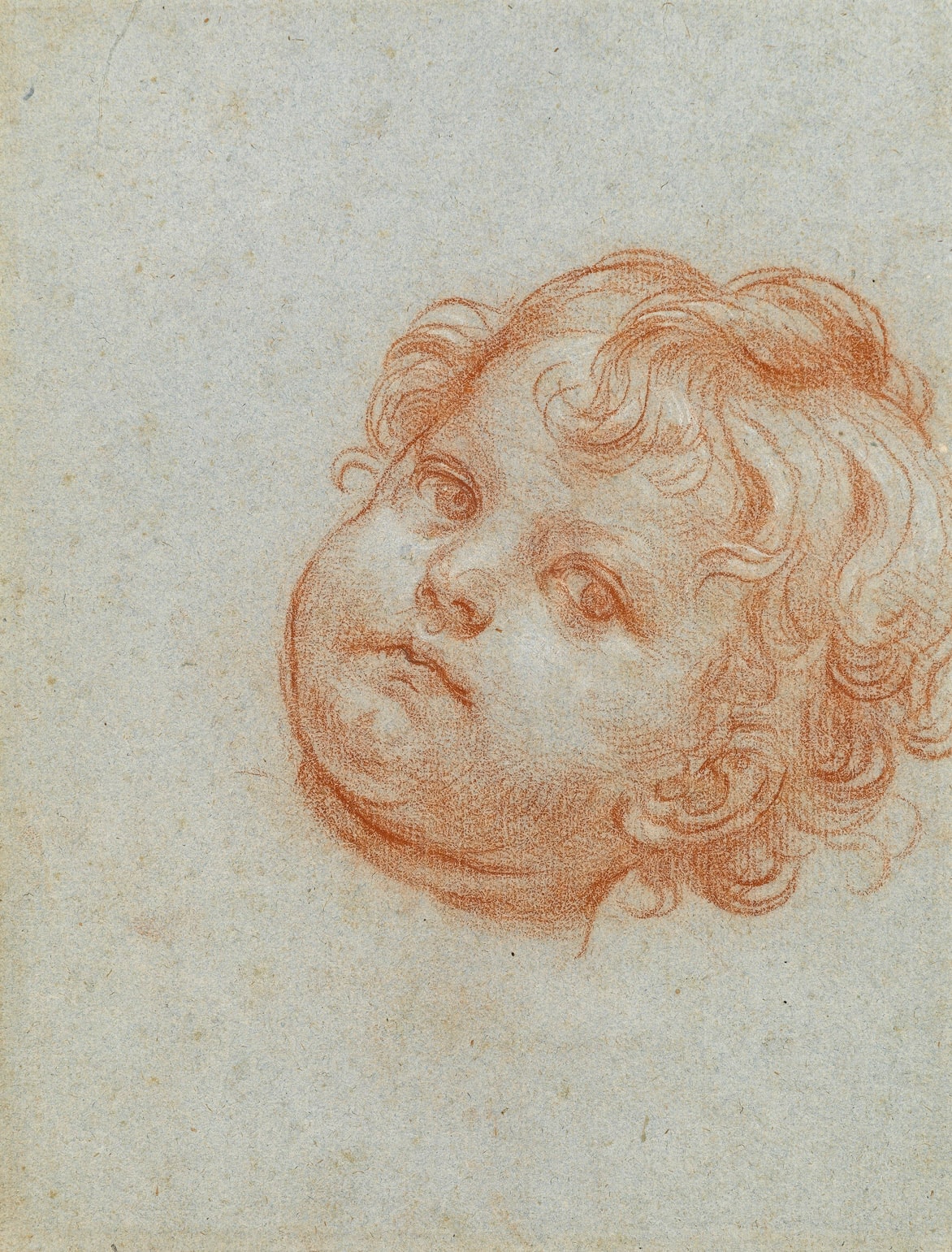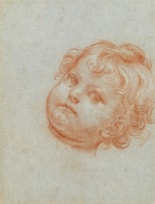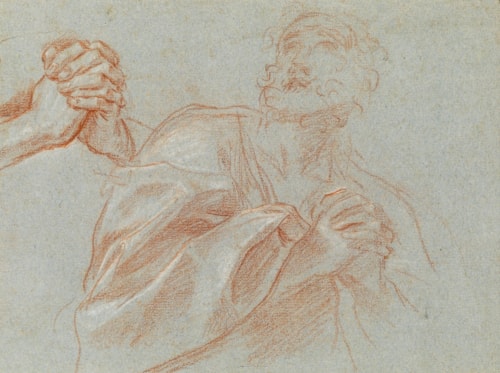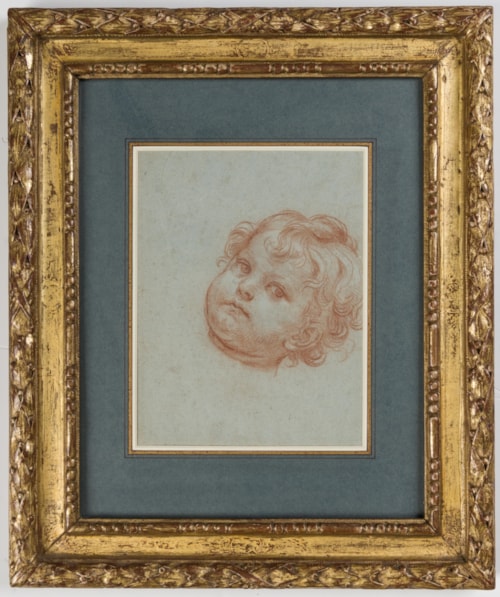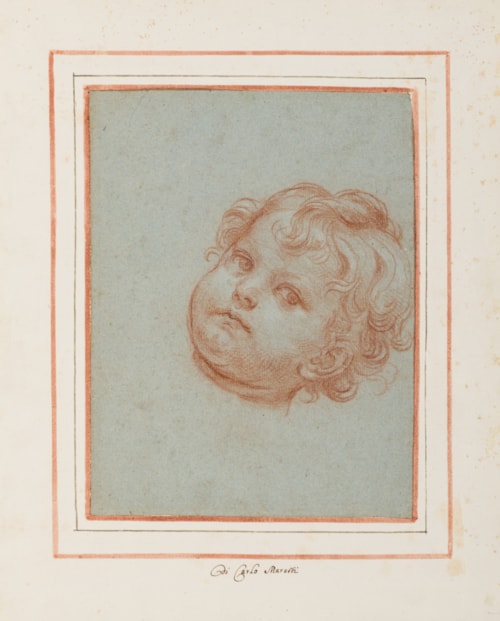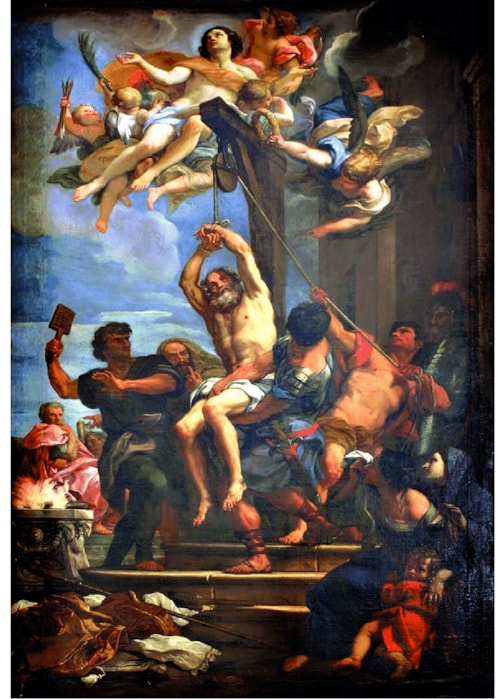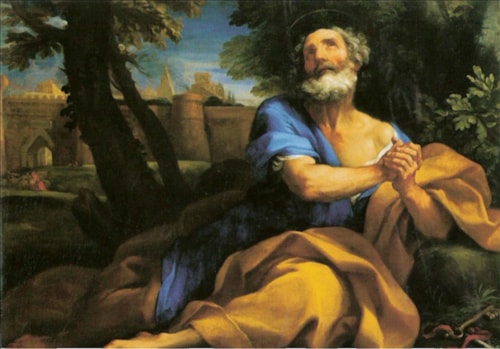Carlo MARATTI
(Camerano 1625 - Rome 1713)
The Head of a Young Boy [recto]; The Penitent Saint Peter [verso]
Red chalk, heightened with touches of white chalk, on blue paper, inlaid on an 18th-century mount.
Inscribed Di Carlo Maratti on both sides of the mount.
267 x 204 mm. (10 1/2 x 8 in.) [sheet]
413 x 319 mm. (16 1/4 x 12 1/2 in.) [mount]
Inscribed Di Carlo Maratti on both sides of the mount.
267 x 204 mm. (10 1/2 x 8 in.) [sheet]
413 x 319 mm. (16 1/4 x 12 1/2 in.) [mount]
Simonetta Prosperi Valenti Rodinò has recently pointed out that the recto of this drawing is a study for the head of the child supported by his mother at the lower right of Maratti’s painting of The Martyrdom of Saint Blaise of c.1676-1678, painted for the Roman church of San Carlo ai Catinari and today in the church of Santa Maria Assunta di Carignano in Genoa. A study in black chalk of the head of the same young boy is among the large collection of drawings by Maratti in Düsseldorf, as is a study of the entire figure of the child.
The late Maratti scholar Stella Rudolph, who described the present sheet as ‘a fine example of the artist’s later graphic manner’, had further noted that the head of a child on the recto of the drawing also appears in Maratti’s painting of The Death of Saint Joseph, dated 1676, in the Kunsthistorisches Museum in Vienna. If the present sheet is viewed horizontally, it can be seen to have been used for the small winged putto that appears just to the left of centre of the composition, over the bed of the dying saint and just below the foot of an angel.
The study of a penitent saint on the verso of the present sheet is a preparatory study for a small painting of The Penitent Saint Peter by Maratti today in the Museo Nazionale di Capodimonte in Naples, which has generally been dated around 1670, but which which Valenti Rodinò has suggested may in fact have been painted around the same time as the Martyrdom of Saint Blaise in Genoa.
The present sheet was once part of an album of drawings by Carlo Maratta and other artists, in all likelihood assembled in the late 17th century or early 18th century. The album included twenty-seven chalk drawings by Maratta, most of which were preparatory studies for paintings, as well as a few drawings by his chief pupil Niccolò Berrettoni and a handful of works by earlier artists including Parmigianino, Agostino Carracci, Taddeo Zuccaro, Federico Barocci and Guercino. The drawings in the album were laid onto mounts inscribed with the names of the artists. Owned by the Shirley family at Ettington Park in Warwickshire, the album was acquired from them in 1937 by P. & D. Colnaghi. Most of the Maratta drawings in the album were acquired from Colnaghi’s by private collectors such as Sir Robert Witt, Sir Brinsley Ford, Villiers David, Sir Thomas Barlow, Frits Lugt and Philip Hofer. Drawings by Carlo Maratta from the Ettington Park album are today in the collections of the Courtauld Institute of Art in London, the Barber Institute of Fine Arts in Birmingham, the Institut Néerlandais (Fondation Custodia) in Paris and the Rijksmuseum in Amsterdam.
The late Maratti scholar Stella Rudolph, who described the present sheet as ‘a fine example of the artist’s later graphic manner’, had further noted that the head of a child on the recto of the drawing also appears in Maratti’s painting of The Death of Saint Joseph, dated 1676, in the Kunsthistorisches Museum in Vienna. If the present sheet is viewed horizontally, it can be seen to have been used for the small winged putto that appears just to the left of centre of the composition, over the bed of the dying saint and just below the foot of an angel.
The study of a penitent saint on the verso of the present sheet is a preparatory study for a small painting of The Penitent Saint Peter by Maratti today in the Museo Nazionale di Capodimonte in Naples, which has generally been dated around 1670, but which which Valenti Rodinò has suggested may in fact have been painted around the same time as the Martyrdom of Saint Blaise in Genoa.
The present sheet was once part of an album of drawings by Carlo Maratta and other artists, in all likelihood assembled in the late 17th century or early 18th century. The album included twenty-seven chalk drawings by Maratta, most of which were preparatory studies for paintings, as well as a few drawings by his chief pupil Niccolò Berrettoni and a handful of works by earlier artists including Parmigianino, Agostino Carracci, Taddeo Zuccaro, Federico Barocci and Guercino. The drawings in the album were laid onto mounts inscribed with the names of the artists. Owned by the Shirley family at Ettington Park in Warwickshire, the album was acquired from them in 1937 by P. & D. Colnaghi. Most of the Maratta drawings in the album were acquired from Colnaghi’s by private collectors such as Sir Robert Witt, Sir Brinsley Ford, Villiers David, Sir Thomas Barlow, Frits Lugt and Philip Hofer. Drawings by Carlo Maratta from the Ettington Park album are today in the collections of the Courtauld Institute of Art in London, the Barber Institute of Fine Arts in Birmingham, the Institut Néerlandais (Fondation Custodia) in Paris and the Rijksmuseum in Amsterdam.
Born in the Marches, Carlo Maratti (or Maratta) entered the Roman studio of Andrea Sacchi in 1636 as a young boy of eleven, and was to remain in Rome for almost the whole of his career. His reputation was established in 1650 with his first public commission, an altarpiece of The Adoration of the Shepherds for the church of San Giuseppe dei Falegnami. He continued to work with Sacchi even as an independent artist, and took over the elder artist’s studio on his death in 1661. Three years later Maratti was elected principe of the Accademia di San Luca, by which time he had established one of the largest and most successful workshops in Rome. He enjoyed a remarkably successful career, receiving numerous important commissions for altarpieces, cabinet pictures and frescoes. Appointed painter to seven popes, as well as King Louis XIV of France, Maratti counted among his patrons the most illustrious Roman families, including the Barberini, Colonna, Rospigliosi, Spada, Pallavicini and Chigi.
Among his many ecclesiastical commissions were the decoration of three chapels in St. Peter’s and altarpieces for the Roman churches of San Carlo al Corso, the Gesù, Santa Maria sopra Minerva, Sant’Andrea al Quirinale and many others. In 1674 Maratti received one of his most important commissions from Pope Clement X, for the extensive fresco decoration of the audience chamber of the Palazzo Altieri; a project left unfinished by the death of the pontiff. He also collaborated with artists such as Nicolas Poussin and Gaspard Dughet, and was in great demand as a portrait painter, particularly among English visitors to Rome. Like Raphael before him, Maratti strove to disseminate his compositions through the medium of prints, and at times created drawings expressly as designs for engravings. Following the death of Gianlorenzo Bernini in 1680 Maratti became the leading artist in the city, and such was his stature that in 1701 he was awarded the unprecedented honour of being named principe for life of the Accademia di San Luca. Although he painted very little in the last decade of his career, his influence remained strong well into the 18th century, as seen in the work of his many pupils and followers, known collectively as the Maratteschi.
In his posthumously published life of the artist, Giovan Pietro Bellori notes that, even as a young artist, Maratti’s skill as a draughtsman was readily apparent: ‘his drawings were already held in great esteem because there was no one who equaled him, and Bernabeo [his elder half-brother] was earning no little profit from them, frequently selling them to foreigners interested in painting, because the skill of a master was apparent in them...’ Maratti’s drawing style differed from that of his master Sacchi in his preference for a more robust definition of form over the softer, more colouristic approach of the elder artist. A prolific draughtsman, he had a preference for red chalk, and made numerous studies of drapery, anatomy and pose for each of his paintings.
Maratti seems to have jealously guarded his drawings, and kept most of them in his studio until his death. (He also assembled a large personal collection of drawings by other artists, including Domenichino and Sacchi, much of which is today in the Royal Library at Windsor Castle.) The majority of Maratti’s surviving drawings, the provenance of which can often be traced back to the artist’s studio, are concentrated in five large groups; in the Louvre, the Royal Collection at Windsor Castle, the Kupferstichkabinett in Berlin, the Museum Kunst Palast in Düsseldorf and the Real Academia de San Fernando in Madrid.
Provenance
From an album of drawings by Maratta and his circle, probably assembled in the early 18th century and later in the possession of the Shirley family, Ettington Park, Stratford-upon-Avon, Warwickshire
The album acquired from Lt. Col. Evelyn Charles Shirley on 26 February 1937 by P. & D. Colnaghi, London
The present sheet acquired from Colnaghi by Hans M. Calmann, London, on 21 April 1943
Anonymous sale, London, Christie’s, 30 March 1976, lot 60
Agnew’s, London, in 1977
Mr. and Mrs. George Walker, Banbury, Oxfordshire
Lewis Reines, New York.
The album acquired from Lt. Col. Evelyn Charles Shirley on 26 February 1937 by P. & D. Colnaghi, London
The present sheet acquired from Colnaghi by Hans M. Calmann, London, on 21 April 1943
Anonymous sale, London, Christie’s, 30 March 1976, lot 60
Agnew’s, London, in 1977
Mr. and Mrs. George Walker, Banbury, Oxfordshire
Lewis Reines, New York.
Literature
James Byam Shaw, The Italian Drawings of the Frits Lugt Collection, Paris, 1983, Vol.I, pp.170-171, under no.168, note 2; Stella Rudolph and Simonetta Prosperi Valenti Rodinò, Carlo Maratti (1625-1713) tra la magnificenza del Barocco e il sogno d’Arcadia: Dipinti e disegni, Rome, 2024, pp.716-717, no.133.16.
Exhibition
London, Thos. Agnew & Sons, Master Drawings, 1977, no.18; Barnard Castle, The Bowes Museum and Newcastle, Hatton Gallery, Pleasure in Drawings, 1980, no.9; Oxford, The Ashmolean Museum, For the Love of Drawing: Drawings from an Oxfordshire Private Collection, 2002.

